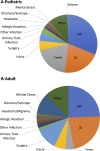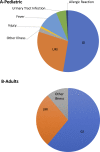Longitudinal Assessment of Illnesses, Stress Dosing, and Illness Sequelae in Patients With Congenital Adrenal Hyperplasia
- PMID: 29584889
- PMCID: PMC6276663
- DOI: 10.1210/jc.2018-00208
Longitudinal Assessment of Illnesses, Stress Dosing, and Illness Sequelae in Patients With Congenital Adrenal Hyperplasia
Abstract
Context: Patients with congenital adrenal hyperplasia (CAH) are at risk for life-threatening adrenal crises. Management of illness episodes aims to prevent adrenal crises.
Objective: We evaluated rates of illnesses and associated factors in patients with CAH followed prospectively and receiving repeated glucocorticoid stress dosing education.
Methods: Longitudinal analysis of 156 patients with CAH followed at the National Institutes of Health Clinical Center over 23 years was performed. The rates of illnesses and stress-dose days, emergency room (ER) visits, hospitalizations, and adrenal crises were analyzed in relation to phenotype, age, sex, treatment, and hormonal evaluations.
Results: A total of 2298 visits were evaluated. Patients were followed for 9.3 ± 6.0 years. During childhood, there were more illness episodes and stress dosing than adulthood (P < 0.001); however, more ER visits and hospitalizations occurred during adulthood (P ≤ 0.03). The most robust predictors of stress dosing were young age, low hydrocortisone and high fludrocortisone dose during childhood, and female sex during adulthood. Gastrointestinal and upper respiratory tract infections (URIs) were the two most common precipitating events for adrenal crises and hospitalizations across all ages. Adrenal crisis with probable hypoglycemia occurred in 11 pediatric patients (ages 1.1 to 11.3 years). Undetectable epinephrine was associated with ER visits during childhood (P = 0.03) and illness episodes during adulthood (P = 0.03).
Conclusions: Repeated stress-related glucocorticoid dosing teaching is essential, but revised age-appropriate guidelines for the management of infectious illnesses are needed for patients with adrenal insufficiency that aim to reduce adrenal crises and prevent hypoglycemia, particularly in children.
Figures


Similar articles
-
Course of COVID-19 infection in patients with congenital adrenal hyperplasia.Front Endocrinol (Lausanne). 2024 Feb 9;15:1348130. doi: 10.3389/fendo.2024.1348130. eCollection 2024. Front Endocrinol (Lausanne). 2024. PMID: 38405151 Free PMC article.
-
Variations in the management of acute illness in children with congenital adrenal hyperplasia: An audit of three paediatric hospitals.Clin Endocrinol (Oxf). 2018 Nov;89(5):577-585. doi: 10.1111/cen.13826. Epub 2018 Sep 24. Clin Endocrinol (Oxf). 2018. PMID: 30086199
-
A Prospective Study of Children Aged 0-8 Years with CAH and Adrenal Insufficiency Treated with Hydrocortisone Granules.J Clin Endocrinol Metab. 2021 Mar 8;106(3):e1433-e1440. doi: 10.1210/clinem/dgaa626. J Clin Endocrinol Metab. 2021. PMID: 32888021 Free PMC article. Clinical Trial.
-
Current and Novel Treatment Strategies in Children with Congenital Adrenal Hyperplasia.Horm Res Paediatr. 2023;96(6):560-572. doi: 10.1159/000522260. Epub 2022 Jan 27. Horm Res Paediatr. 2023. PMID: 35086098 Review.
-
Adrenal crises: perspectives and research directions.Endocrine. 2017 Feb;55(2):336-345. doi: 10.1007/s12020-016-1204-2. Epub 2016 Dec 19. Endocrine. 2017. PMID: 27995500 Review.
Cited by
-
The Impact of SARS-Cov-2 Virus Infection on the Endocrine System.J Endocr Soc. 2020 Jul 2;4(8):bvaa082. doi: 10.1210/jendso/bvaa082. eCollection 2020 Aug 1. J Endocr Soc. 2020. PMID: 32728654 Free PMC article. Review.
-
Insights in the maturational processes influencing hydrocortisone pharmacokinetics in congenital adrenal hyperplasia patients using a middle-out approach.Front Pharmacol. 2023 Jan 12;13:1090554. doi: 10.3389/fphar.2022.1090554. eCollection 2022. Front Pharmacol. 2023. PMID: 36712688 Free PMC article.
-
Phase 3 Trial of Crinecerfont in Adult Congenital Adrenal Hyperplasia.N Engl J Med. 2024 Aug 8;391(6):504-514. doi: 10.1056/NEJMoa2404656. Epub 2024 Jun 1. N Engl J Med. 2024. PMID: 38828955 Free PMC article. Clinical Trial.
-
Trends in hospital admissions for adrenal insufficiency in adolescents and young adults in the 21st century.Front Endocrinol (Lausanne). 2022 Sep 20;13:986342. doi: 10.3389/fendo.2022.986342. eCollection 2022. Front Endocrinol (Lausanne). 2022. PMID: 36204108 Free PMC article.
-
Interpretation of Steroid Biomarkers in 21-Hydroxylase Deficiency and Their Use in Disease Management.J Clin Endocrinol Metab. 2023 Aug 18;108(9):2154-2175. doi: 10.1210/clinem/dgad134. J Clin Endocrinol Metab. 2023. PMID: 36950738 Free PMC article. Review.
References
-
- Falhammar H, Frisén L, Norrby C, Hirschberg AL, Almqvist C, Nordenskjöld A, Nordenström A. Increased mortality in patients with congenital adrenal hyperplasia due to 21-hydroxylase deficiency. J Clin Endocrinol Metab. 2014;99(12):E2715–E2721. - PubMed
-
- Gidlöf S, Falhammar H, Thilén A, von Döbeln U, Ritzén M, Wedell A, Nordenström A. One hundred years of congenital adrenal hyperplasia in Sweden: a retrospective, population-based cohort study. Lancet Diabetes Endocrinol. 2013;1(1):35–42. - PubMed
-
- Speiser PW, Azziz R, Baskin LS, Ghizzoni L, Hensle TW, Merke DP, Meyer-Bahlburg HF, Miller WL, Montori VM, Oberfield SE, Ritzen M, White PC; Endocrine Society . Congenital adrenal hyperplasia due to steroid 21-hydroxylase deficiency: an Endocrine Society clinical practice guideline. J Clin Endocrinol Metab. 2010;95(9):4133–4160. - PMC - PubMed
-
- Mallappa A, Sinaii N, Kumar P, Whitaker MJ, Daley LA, Digweed D, Eckland DJ, Van Ryzin C, Nieman LK, Arlt W, Ross RJ, Merke DP. A phase 2 study of Chronocort, a modified-release formulation of hydrocortisone, in the treatment of adults with classic congenital adrenal hyperplasia. J Clin Endocrinol Metab. 2015;100(3):1137–1145. - PMC - PubMed
Publication types
MeSH terms
Substances
LinkOut - more resources
Full Text Sources
Other Literature Sources
Medical

